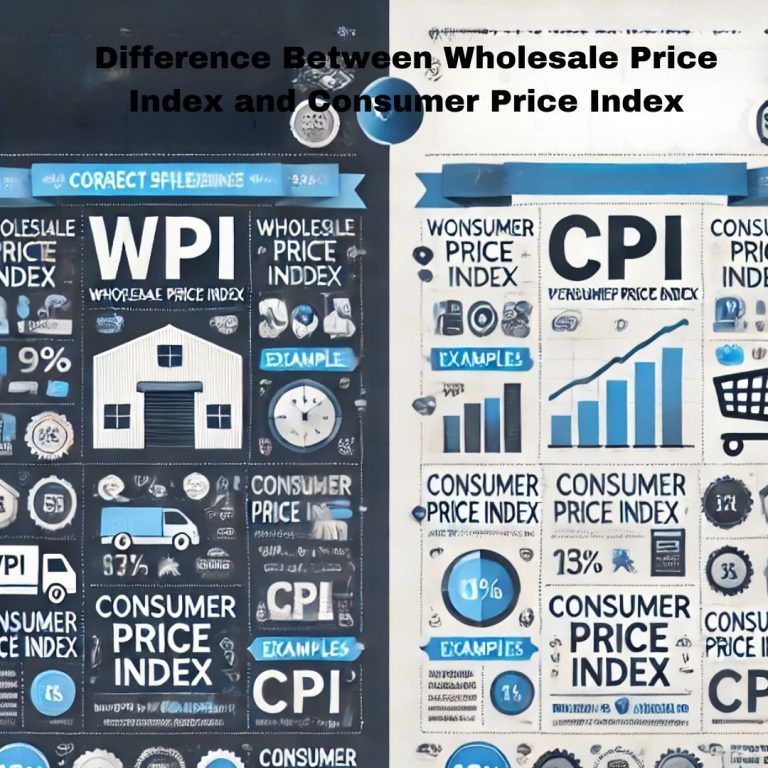The Difference Between Wholesale Price Index and Consumer Price Index lies in their scope, purpose, and coverage. Both indices measure inflation but at different levels. The Wholesale Price Index (WPI) tracks the average price changes in bulk commodities traded between businesses, while the Consumer Price Index (CPI) measures changes in retail prices affecting consumers. Understanding these indices is crucial for policymakers, businesses, and individuals as they directly impact economic planning, monetary policies, and living costs.
What is the Wholesale Price Index (WPI)?
The Wholesale Price Index (WPI) measures the average change in prices of goods at the wholesale level, i.e., the price at which goods are traded between businesses before reaching the consumer.
- Scope: Focuses on wholesale market transactions.
- Goods Covered: Includes raw materials, intermediate goods, and finished products.
- Purpose: Tracks price trends in bulk goods to monitor inflationary pressures in the supply chain.
Components of WPI
- Primary Articles: Agricultural products, minerals, etc.
- Fuel and Power: Coal, electricity, petroleum.
- Manufactured Goods: Textiles, chemicals, machinery, etc.
Example: If the WPI increases by 5% in a year, it implies a rise in wholesale prices of goods by 5%.
Who Releases the Wholesale Price Index?
The Ministry of Commerce and Industry in India releases the Wholesale Price Index. The WPI is calculated weekly and monthly to track inflation trends.
- Relevance: Used as a primary indicator for inflation before the adoption of CPI as the main measure.Provides insights into the cost structure of industries and the economy.
- Global Context: In many countries, similar indices exist, but their methodologies and components may vary.
What is the Consumer Price Index (CPI)?
The Consumer Price Index (CPI) measures the average change in prices paid by consumers for a basket of goods and services over time. It reflects the cost of living and the purchasing power of consumers.
- Scope: Captures price changes at the retail level.
- Goods and Services Covered: Includes essential items like food, housing, healthcare, and transportation.
- Purpose: Monitors inflation from the consumer’s perspective, influencing monetary policies and wage adjustments.
Components of CPI:
- Food and Beverages: A significant weight in CPI calculation.
- Housing: Rent, utilities, and maintenance costs.
- Miscellaneous Services: Education, medical expenses, etc.
What is the Most Common CPI Index?
The most common Consumer Price Index (CPI) index is the CPI for All Urban Consumers (CPI-U), which measures the average change in prices paid by urban households for goods and services.
- CPI for Industrial Workers (CPI-IW): Tracks inflation affecting industrial workers.
- CPI for Agricultural Laborers (CPI-AL): Focuses on rural inflation.
- CPI Combined (CPI-C): Averages urban and rural indices, widely used for monetary policy decisions.
Importance:
The CPI Combined serves as the primary measure for inflation targeting by the Reserve Bank of India (RBI). Globally, CPI is a key metric for economic comparisons between countries.
Difference Between the Wholesale Price Index and the Consumer Price Index
The Wholesale Price Index (WPI) measures price changes at the wholesale level, while the Consumer Price Index (CPI) tracks price changes for consumers at the retail level.
| Aspect | Wholesale Price Index (WPI) | Consumer Price Index (CPI) |
| Definition | Measures price changes at the wholesale level. | Tracks retail price changes for consumers. |
| Scope | Bulk transactions between businesses. | End-user consumption. |
| Coverage | Focuses on goods. | Includes goods and services. |
| Purpose | Indicates supply-side inflation. | Reflects cost of living and demand-side inflation. |
| Weightage | High weightage for manufacturing goods. | High weightage for food and housing. |
| Released By | Ministry of Commerce and Industry. | Ministry of Statistics and Programme Implementation. |
Practical Example:
- A rise in WPI indicates increased production costs, possibly leading to higher retail prices later.
- A surge in CPI directly affects household expenses, reducing purchasing power.
Conclusion
The Difference Between Wholesale Price Index and Consumer Price Index highlights their complementary roles in inflation measurement. While WPI reflects price trends at the wholesale level, CPI focuses on retail price changes affecting consumers. Both indices are vital for economic planning, but CPI has become the preferred measure for inflation targeting due to its relevance to consumer behavior. Understanding these indices empowers individuals, businesses, and policymakers to make informed financial decisions.
Difference Between Wholesale Price Index and Consumer Price Index FAQs
Why is CPI more relevant for inflation targeting than WPI?
CPI reflects consumer-level inflation, directly impacting purchasing power and cost of living, making it more relevant for monetary policies.
Who releases the Consumer Price Index?
The Ministry of Statistics and Programme Implementation in India releases the CPI.
Can WPI influence CPI?
Yes, a rise in WPI can lead to increased production costs, eventually raising retail prices reflected in CPI.
What is the most common CPI used in India?
The CPI Combined is the most commonly used for inflation tracking and policy decisions.
How does the coverage of WPI differ from CPI?
WPI covers wholesale goods, while CPI includes both goods and services purchased by end consumers.


